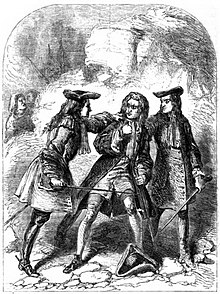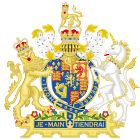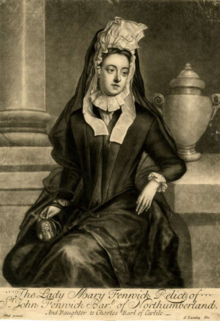| Sir John Fenwick, 3rd Baronet | |
|---|---|
 | |
| Born | c1645 |
| Died | 28 January 1697 London |
| Nationality | Kingdom of England |
| Occupation(s) | MP and Jacobite conspirator |
| Known for | executed for treason |
| Spouse | Mary Fenwick born |
| Parent | Sir William Fenwick |
Sir John Fenwick, 3rd Baronet (c. 1645 – 28 January 1697) was an English Army officer and politician. He succeeded to the Fenwick baronetcy after the death of his father, Sir William Fenwick. A supporter of the Jacobite cause, Fenwick was involved in a conspiracy to assassinate William III of England, and was executed by beheading in 1697 as a result.
Life
Fenwick was the eldest son of Sir William Fenwick, or Fenwicke, a member of an old Northumberland family. He entered the army, becoming major-general in 1688, but before this date, he had been returned in succession to his father as one of the Members of Parliament for Northumberland, which county he represented from 1677 to 1687. He was a strong partisan of King James II, and in 1685 was one of the principal supporters of the act of attainder against the Duke of Monmouth; but he remained in England when William III ascended the throne in the Revolution of 1688.
He had financial problems and in 1688 he sold the rump of the family estates and Wallington Hall to Sir William Blackett for £4,000 and an annuity of £2,000 a year. The annuity was to be paid for his lifetime and that of his wife, Mary. Blackett was happy with the deal as he discovered lead on the land and he became rich.

Fenwick began to plot against the new King William, for which he underwent a short imprisonment in 1689 from May to October. Renewing his plots on his release, he publicly insulted Queen Mary in 1691, and it is practically certain that he was implicated in the schemes for assassinating William which came to light in 1695 and 1696. After the seizure of his fellow conspirators, Robert Charnock and others, he remained in hiding until the imprudent conduct of his friends in attempting to induce one of the witnesses against him to leave the country led to his arrest in June 1696.
United Kingdom legislation| Attainder of Sir John Fenwick Act 1696 | |
|---|---|
| Act of Parliament | |
 Parliament of England Parliament of England | |
| Long title | An Act to attaint Sir John Fenwick Baronett of High Treason. |
| Citation | 8 & 9 Will. 3. c. 4 |
| Other legislation | |
| Repealed by | Statute Law (Repeals) Act 1977 |
| Status: Repealed | |
| Text of statute as originally enacted | |
To save himself he offered to reveal all he knew about the Jacobite conspiracies; but his confession was a farce, being confined to charges against some of the leading Whig noblemen, which were damaging, but not conclusive. By this time his friends had succeeded in removing one of the two witnesses, and in these circumstances, it was thought that the charge of treason must fail. The government, however, overcame this difficulty by introducing a bill of attainder. After a long and acrimonious discussion the bill passed through both Houses of Parliament (Act 8 & 9 Will. 3. c. 4), finding Fenwick guilty of high treason, punishable by death. His wife, Mary, persevered in her attempts to save his life, but her efforts were fruitless, and Fenwick was beheaded in London on 28 January 1697, with the same formalities as were usually observed at the execution of a peer. He was the last person ever executed under an Act of Attainder.

By his wife, Mary (d. 1708), daughter of Charles Howard, 1st Earl of Carlisle, and his wife Anne Howard, he had three sons and one daughter, all of whom died young, and are buried with Fenwick at St Martin-in-the-Fields.
Macaulay wrote that of all the Jacobites, the most desperate characters not excepted, he (Fenwick) was the only one for whom William felt an intense personal aversion. Fenwick's hatred of the king is said to date from the time when he was serving in Holland, and was reprimanded by William, then Prince of Orange. A horse, White Sorrel, owned by Fenwick was among items of his estate confiscated by the Crown on his attainder and a fall from that horse was partly responsible for William's death. The horse purportedly stumbled when it stepped on a molehill. In recognition of this, the Jacobites' secret toast was to "The little Gentleman in Black Velvet." He is also commemorated in the folk tune Sir John Fenwick's The Flower Among Them All.
His wife had a memorial created for him in York Cathedral and she was buried there after she died on 27 October 1708.
Notes
- "BLACKETT, Sir William, 1st Bt. (1657-1705), of Greyfriars House, Newcastle-upon-Tyne and Wallington Hall, Northumb. | History of Parliament Online". www.historyofparliamentonline.org. Retrieved 6 May 2021.
- ^ "Fenwick, John (1645?-1697)" . Dictionary of National Biography. London: Smith, Elder & Co. 1885–1900.
- ^ Chisholm 1911.
- "William III, 1696-7: An Act to attaint Sir John Fenwick Baronett of High Treason. [Chapter IV. Rot. Parl. 8&9 Gul.III.p.1.nu.4.] | British History Online". www.british-history.ac.uk. Retrieved 6 May 2021.
- "House of Lords Journal Volume 16: 15 January 1697 Pages 59-73 Journal of the House of Lords: Volume 16, 1696-1701. Originally published by His Majesty's Stationery Office, London, 1767-1830". British History Online. Retrieved 13 July 2020.
References
- "Northumbrian Jacobites". Archived from the original on 15 April 2004.
- "Proceedings in Parliament against Sir John Fenwick, bart. upon a bill of attainder for High Treason". A Complete Collection of State Trials and Proceedings for High Treason and Other Crimes and Misdemeanors. 13 (394, column 537). 1812.
Attribution:
 This article incorporates text from a publication now in the public domain: Chisholm, Hugh, ed. (1911). "Fenwick, Sir John". Encyclopædia Britannica. Vol. 10 (11th ed.). Cambridge University Press. p. 260.
This article incorporates text from a publication now in the public domain: Chisholm, Hugh, ed. (1911). "Fenwick, Sir John". Encyclopædia Britannica. Vol. 10 (11th ed.). Cambridge University Press. p. 260.- Old Bailey Proceedings Online (accessed 20 Jan 2022), Trial of John Fenwick. (o16960909-1, 9 September 1696).
| Parliament of England | ||
|---|---|---|
| Preceded bySir William Fenwick Viscount Mansfield |
Member of Parliament for Northumberland 1677–1687 With: Sir Ralph Delaval 1677–1685 William Ogle 1685–1687 |
Succeeded byWilliam Forster Philip Bickerstaffe |
| Military offices | ||
| Preceded byThe Earl of Plymouth | Colonel of Fenwick's Regiment of Horse 1687–1688 |
Succeeded byViscount Colchester |
| Baronetage of England | ||
| Preceded byWilliam Fenwick | Baronet (of Fenwick) 1676–1697 |
Attainted |
- 1640s births
- 1697 deaths
- 3rd Dragoon Guards officers
- Baronets in the Baronetage of England
- English Jacobites
- English generals
- 17th-century English soldiers
- English MPs 1661–1679
- English MPs 1679
- English MPs 1680–1681
- English MPs 1681
- English MPs 1685–1687
- People executed by Stuart England by decapitation
- People executed under the Stuarts for treason against England
- Executed English people
- 17th-century English criminals
- English politicians convicted of crimes